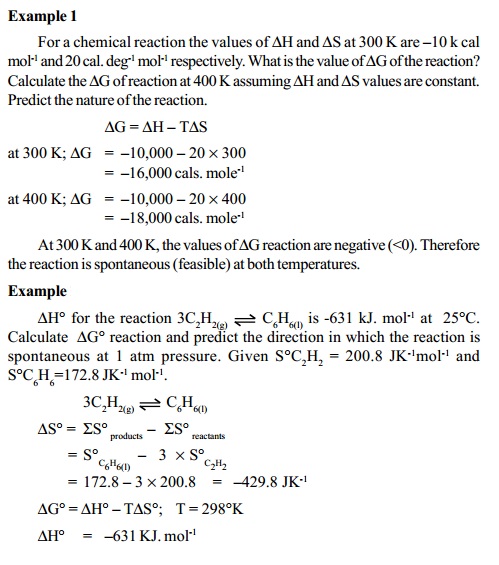Chapter: 11th 12th std standard Class Organic Inorganic Physical Chemistry Higher secondary school College Notes
Characteristics of Free energy 'G'
Characteristics of Free energy 'G'
i) G is defined as (H-TS) where H and S are the enthalpy
and entropy of the system
respectively. T = temperature. Since H and S are state functions, G is a state function.
ii) G is an extensive property while DG = (G2-G1) which is
the free energy change between the
initial (1) and final (2) states of the system becomes the intensive property when mass remains constant between
initial and final states (or) when the
system is a closed system.
iii) G has a single value for the thermodynamic state
of the system.
iv) G and DG values correspond
to the system only. There are three cases of DG in predicting the nature of the process. When, DG<0 (negative), the process
is spontaneous and feasible; DG = 0. The process is in equilibrium and DG > 0 (positive), the process is nonspontaneous and
not feasible.
v) DG
= DH - TDS. But according to
I law of thermodynamics,
DH = DE + PDV and DE = q - w.
∴ DG = q - w + PDV
- TDS
But DS = q/T and TDS = q = heat involved in the process.
∴ DG = q - w + PDV
- q = -w + PDV
(or) -DG = w - PDV
= network.
The decrease in free energy -DG, accompanying a process taking place at constant
temperature and pressure is equal to the maximum obtainable work from the system other than work of expansion.
This quantity is called as the "net work" of
the system and it is equal to (w - PDV).
∴ Net work = -DG = w - PDV.
-DG
represents all others forms of work obtainable from the system such as
electrical, chemical or surface work etc other than P-V work.
Standard free energy (G o )
Like standard enthalpy of formation of substances,
standard enthalpy change of a reaction,
standard free energy of formation of substances and standard free energy change
of reactions are considered. The standard free energy value (G o ) of all
substances either elements or compounds may be calculated from H o and S o values at standard conditions of temperature (298 K)
and pressure (1 atm) and the substance
being present in the standard state.
i.e G o = H o - TS o
Standard free energies of formation of elements are taken
as zero. Hence, standard free
energy change of a reaction which is stoichiometrically balanced, is equal to the difference between the total sum of the
standard free energies of products and
the total sum of the standard free energies of reactants, at standard conditions.
DG o reaction = SG o product - SG o reactants
DG o reaction can also be
calculated from DH o reaction and DS o reaction values. DH o reaction and DS o reaction can be calculated
from H o f and S o values of respective product and reactant molecules at the constant temperature and pressure.


Related Topics